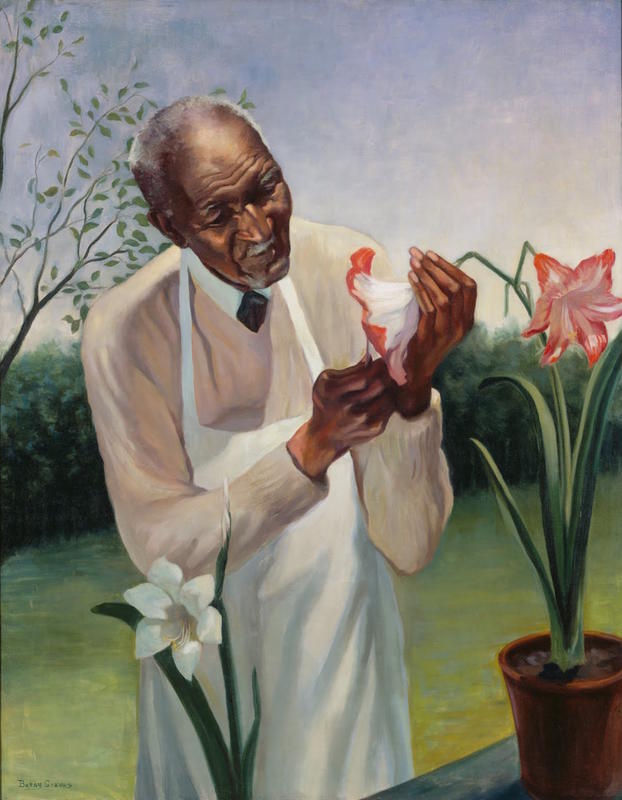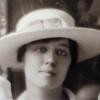More about George Washington Carver
- All
- Info
- Shop

Contributor
George Washington Carver by Betsy Graves Reyneau is a portrait of the “Peanut Man” himself.
Los Angeles has George Washington Carver to thank for the invention of nut-milk. The invention of peanut butter was also attributed to Carver, but that’s #fakenews. Carver was an agricultural scientist who, among many other accomplishments, wrote the book "How to Grow the Peanut and 105 Ways of Preparing it for Human Consumption." He performed hundreds of influential experiments and advocated for the growing of peanuts, sweet potatoes, and soybeans as opposed to cotton, which was highly popular at the time. Carver discovered that crop rotation (the act of alternating seasonally what is planted on one given piece of land) helped the increase nutrients in the soil and boosted crop yields for following seasons. And for that he became a hero in the eyes of the American public. Yay, Science!
Carver was born into slavery in the 1860s. His parents were a couple owned by Moses Carver and his exact birthday is not known. As a week-old baby, George, his mother, and his sister, were kidnapped by raiders from Arkansas and sold in Kentucky. When Moses Carver hired someone to find them, only George was found. After slavery was abolished, Moses and his wife Susan decided to raise George and his brother, James, as their own, teaching them to read and write because no school in the area would accept black students. This was the case for many high schools and colleges as well, but Carver, dedicated to his education, found a way to earn his high school, bachelor's, and master's degrees.
Through his studies, Carver established himself as an absurdly talented botanist and plant pathologist. He did research and taught at Tuskagee Institute in Alabama for the remainder of his career. Carver also brought his teachings on the road with the development of the “Jesup wagon,” a mobile classroom that he would bring to farms in order to teach farmers about crop rotation and alternate cash crops for areas overrun with cotton farms. In this way, Carver “helped to stabilize the livelihoods of people, many former slaves who had backgrounds not unlike [his] own.” His acclaim became widespread, and leaders such as Booker T. Washington, President Theodore Roosevelt, and Gandhi asked for his agricultural advice.
On January 5, 1943, Carver died from complications after falling down the stairs at home. His legacy includes The George Washington Carver Museum, which one could call the peanut gallery, a national monument where Carver lived as a child, and a feature on U.S. postal stamps and a half dollar coin, and many schools that bear his name. His tombstone reads, “He could have added fortune to fame, but caring for neither, he found happiness and honor in being helpful to the world." What a beautiful man. In addition to fortune and fame, Carver was also humble, and for a long time he refused to have his portrait painted. That is, until he saw the work of Betsy Graves Reyneau. Carver believed that Reyneau painted “the souls of people,” which is why he is depicted handling "a red-and-white amaryllis, a hybrid that he developed as part of a lifelong hobby.” Depicted here is Carver’s soul.
Sources
- Bagley, Mary. "George Washington Carver: Biography, Inventions & Quotes." Live Science. N.p., 2013. Web. 17 July 2018.
- Carver, George Washington. "How To Grow The Peanut And 105 Ways Of Preparing It For Human Consumption | Fruit & Nut Resources." Aggie-horticulture.tamu.edu. N.p., 2018. Web. 17 July 2018.
- "Dr. Carver Is Dead; Negro Scientist." Archive.nytimes.com. N.p., 1943. Web. 17 July 2018.
- "George Washington Carver." Biography.com. N.p., 2018. Web. 17 July 2018.
- "George Washington Carver: Scientist And "Miracle Worker" | National Portrait Gallery." Npg.si.edu. Web. 17 July 2018.
- Kettler, Sara. "7 Facts On George Washington Carver." Biography. N.p., 2015. Web. 17 July 2018.












